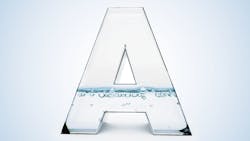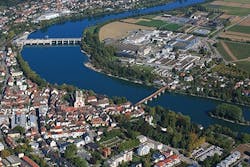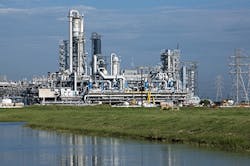Water Security: Some Chemical Companies Get an “A”
Global non-profit organization CDP, London, which started as the Carbon Disclosure Project soliciting inputs about carbon emissions, broadened its mission a number of years ago to water sustainability as well, asking companies to fill out an extensive and detailed questionnaire about their efforts. For 2019, 2,433 firms responded. Of these, CDP put 72 companies on its Water Security A List for superior transparency and performance.
Chemical companies on the Water Security A List include Novartis, BASF, Bayer and Air Liquide. Their responses highlight the wide range of challenges the industry faces to manage water sustainably.
Novartis chose to participate in the CDP water report for several reasons, says head of water resources Jutta Hellstern. “It increases our transparency on these topics through standardized disclosure procedures, which allow our key stakeholders to understand our impact and risk mitigation processes. And it is used as a vehicle to inform senior leaders to set the right priorities for the business and as a reference for investors and associated rating agencies.”
The report reveals that Novartis consumes 2,068 megaliters (ML)/yr of water; this includes losses due to evaporation from heating and cooling systems together with water used in products.
Several Novartis sites use large quantities of water to cool production processes or buildings. A site in Austria incurs the largest demand.
“If this site was unable to obtain water for cooling, mechanical chillers would be required to cool the processes and buildings, which would result in significantly higher operating costs and increased capital costs. The estimated costs are $10 million over 5–10 years, plus the annual increase in energy costs of $1.5–2.5 million,” she explains.
The company’s environmental sustainability strategy aims both to reduce the volume of water that isn’t returned to the environment and to increase its recycling.
“The technologies used to achieve this include membrane bioreactor (MBR) technology combined with active carbon (AC) filtration and followed by reverse osmosis (RO). Recovered water can be used for cooling towers, boiler feed water and/or air pollution control technologies such as solvent scrubbers,” adds Hellstern.
Novartis’ global health, safety and environment team is spearheading its environmental sustainability strategy. That group also focuses on other factors such as enhancing awareness for efficient water use (reduce, reuse, recycle), improving overall utilization, and eliminating oversized or redundant water systems.
As an example of this strategy in action, Hellstern points to a manufacturing site in Turkey. It has decreased water consumption and increased the quality of effluent by installing an RO/ultrafiltration system that allows the site to reuse a proportion of the water. The project cost about $600,000 but cut water consumption by 14% and provided operational savings of $100,000/yr.
“The 200m3/day RO/ultrafiltration system recovers between 14,000 and 21,000 m3/yr of recycled water,” she adds.
Hellstern also cites a project at a Singapore facility: “Here, we used MBR, AC and RO technologies to recycle 25,000 m3/yr of water. Water consumption was reduced by 27% and operational costs were cut by $35,000/yr.”
Figure 1. Water from the Rhine River provides cooling for office and research buildings at company headquarters in Basel, Switzerland. Source: Novartis.
Meanwhile at its headquarters in Basel, Switzerland, Novartis is using water from the nearby Rhine River to cool office and research buildings (Figure 1). To avoid energy-intensive mechanical chilling, the company opted for seasonal heat storage technology for new buildings at the site. Following a successful pilot application in 2014, Novartis has equipped three more buildings with the same technology.
Costly Drought
Meanwhile, BASF, Ludwigshafen, Germany, withdraws 174,500 ML/yr of water and discharges 161,400 ML/yr, according to its response to the CDP questionnaire. The difference mainly stems from evaporation in recirculating cooling processes. A smaller fraction goes into products or gets consumed by other processes.
The questionnaire also reveals the cost of the 2018 drought and high temperatures experienced at Ludwigshafen, which is the company’s largest site.
The site relies on the adjacent Rhine River in two ways: for onsite water mainly for cooling purposes, and to transport raw materials and final products via barges.
The exceptional drought and unusual heat in 2018 caused an extremely long and intense phase of low river water levels and very high water temperatures during the peak of the heatwave. The low water levels restricted transport by barge, ultimately leading to a loss of around €250 million ($275 million), mainly due to an inability to transport raw materials. The high water temperature limited cooling capacity.
Since then, BASF has implemented €20 million ($22 million) of specific, targeted measures to increase the resilience of the Ludwigshafen site against potentially more frequent and prolonged phases of very low water levels and very high water temperature. These include expansion of storage capacity, alternative choices for transport, and an increase in re-cooling capacity at the site.
Water issues also pose a risk to operations at BASF’s complex in Freeport, Texas, notes the questionnaire. The threat comes from rising municipal and industrial demand for water in the area, a situation that is predicted to last for decades.
BASF speculates this could result in greater competition between different users for existing river and groundwater sources, and a higher price for water in the future.
Increased production at the Freeport site in 2018 boosted water demand by around 5%, which was supplied by taking more groundwater, notes the company. However, in the future, sufficient additional groundwater may not be available; thus, the company may need to consider alternative sources for water as well as internal efficiency measures.
Alternative sources present their own challenges, BASF acknowledges. For example, only small quantities of municipal wastewater may be available. Sea water is abundant but the necessary desalination makes it the most energy-intensive option. The company’s analyses have shown that substituting 5% of Freeport’s existing water supplies with desalinated water would result in significantly higher operating costs.
So, BASF now is assessing current and future water demand versus availability at the site, investigating additional water sources and intensive internal re-use, and carrying out economic evaluations of alternative water supply options (Figure 2).
Figure 2. Concern over water supplies is prompting extensive economic evaluations of alternatives sources for Freeport site. Source: BASF.
This is accompanied by specific implementation planning to tap additional water withdrawal sources, for example, by capital spending for desalination infrastructure and investment partnerships with other industrial plants in the Freeport area.
A Potent Tool
Bayer, Leverkusen, Germany, considers participating with CDP an important element in its efforts to be transparent and make information accessible.
“We use the process of answering the questionnaire to challenge our own processes and initiate improvement. Additionally, we see a positive reaction from investors and the public on the strong performance in a reputable rating like CDP,” notes Dirk Frenzel, company spokesperson on sustainability.
Bayer’s responses show that the company’s total water withdrawal in 2018 was 42,108 ML, with 18,280 ML discharged. The difference largely stems from quantities of water used as raw materials in products, unquantified losses due to evaporation, leaks and volumes of condensate generated by using steam as a source of energy.
Bayer considers a supply of fresh water essential, with the resource primarily going for cooling and production processes (Figure 3), plus for irrigating fields and greenhouses for seed production. A lack of water also could impede raw material/product supply or hamper the use of its crop science products.
Figure 3. Company requires water for processes such as fermentation (shown) as well as for cooling. Source: Bayer.
Using the “Aqueduct Water Risk Atlas,” a tool from the World Resources Institute (WRI), Washington, D.C., that maps and analyzes current and future water risks across locations, together with its in-house monitoring system BaySIS (Bayer Site Information System), the company identified ten sites — eight in the U.S., one in Puerto Rico and one in Peru — in regions at water risk. Each potentially could face substantive business impact from water shortages. The company now is developing site-specific projects for water reuse/recycling/reduction.
The questionnaire also probes the potential for reputational damage. One section asks companies to provide details of identified risks in operations that possibly could lead to significant financial or strategic impact on the business — and the response to those risks.
Here, Bayer highlights its operations in India, pointing out that pollution due to chemical residues in water is a general problem in the country, not one specific to the company. Bayer notes that, with the Indian government’s zero-liquid-discharge strategy, news media would quickly pick up on any pollution incidents and the state pollution control board would stop plant production. The company reckons that brand damage that wiped 0.1% off its stock price (as of year-end 2018) would reduce the company’s market capitalization by around €56.5 million ($62 million).
So, Bayer’s facilities in India have installed online analyzers for monitoring critical parameters at the effluent treatment plant (ETP) outlet; these upload live data to the pollution control board server and automatically shut the discharge valve when limits are exceeded. There is a holding capacity of more than ten days between receipt of generated process wastewater in the ETP and discharge after biological treatment and final discharge. “This provides ample scope for action even in worst case scenario of failure in treatment process,” notes the company.
However, Frenzel cautions that the CDP report approach might not suit every company. “The idea and commitment of the CDP water program is powerful and creates a benefit to improve your own program, win confidence of investors and the public. Participation, nevertheless, requires an experienced sustainability team and established processes, and a solid database as the questionnaire is quite comprehensive. Depending on these preconditions, the effort compared to benefit might be too high,” he warns.
Expecting Greater Demand
In 2018, Air Liquide, Paris, withdrew 394,000 ML of water and discharged 308,000 ML. “The group’s water usage is mostly related to the cooling process of rotating machines, in particular for the production of air gases, or to its use as a raw material for products such as hydrogen. Conscious of the depletion of vital resources such as water, Air Liquide set up a couple of years ago a task force to improve data collection and better manage water consumption on its production sites,” explains a spokeswoman.
One target, for example, is to change the ratio of different cooling circuits used in air separation units. Currently around 54% of these units have semi-open water recirculating systems and 38% open systems, both of which require back-up water. The remaining 8% have closed systems.
The task force also is focused on longer-term planning after an analysis using the WRI’s “Aqueduct Water Risk Atlas” showed that 6% of the company’s sites are located in countries that will be under extremely high water stress by 2030.
While the company aims to optimize its current water use for cooling, it also hopes to use more water — as a feedstock for the production of clean hydrogen by water electrolysis.
“The focus on electrolysis makes water a raw material for Air Liquide processes and further increases the importance of this precious resource for the company,” notes its CDP questionnaire. The company also points to the 2017 report “Hydrogen, Scaling Up” by the Hydrogen Council, Brussels, which states that hydrogen has the potential to develop €2.2 trillion ($2.38 trillion) of business by 2050.
Air Liquide is demonstrating the advantages of this technology with several projects around the world. For example, HyBalance in Europe will supply five hydrogen charging stations in Denmark for 60 fuel-cell electric vehicles. In the U.S., a Braintree, Mass., hydrogen fueling station will utilize an innovative pathway for hydrogen sourcing: proton exchange membrane (PEM) electrolysis to produce hydrogen onsite. Air Liquide also has announced the construction in Canada of the world’s largest PEM electrolyzer — a 20-MW-capacity unit at Bécancour, Québec, to make carbon-free hydrogen.
Air Liquide’s spokeswoman also had a word of caution for companies considering the CDP report route: “Submitting to the CDP water questionnaire brings interesting topics of discussion. However, industry companies have to take into account that this questionnaire is generic and doesn't always fit company-specific business reporting.”




